#its also not mutually exclusive for the record
Explore tagged Tumblr posts
Text
“transphobia hurts us all” is an analytical statement. It is making a claim about how a specific bigotry operates in the world, and its supposed analytical value is in revealing something about transphobia that appears on the surface to be counter-intuitive - “while you might think transphobia only hurts transgender people, that isn’t the case; it hurts cisgender people too.” The follow-up to this statement, sometimes implied and sometimes explicit, is a moral imperative - transphobia is a social ill that hurts us all, so we should seek to get rid of it.
This analytical-moral chain of logic isn’t unique to this statement; a lot of analyses of the social world come from a broader desire to “figure out what to do.” When we investigate a social phenomenon to uncover its inner workings, and in this investigation we identify the scope and impact of the harm it causes, we are in a better place to understand how to reduce harm in the world. Of particular interest in this investigation of transphobia is highlighting its illegitimacy - if transphobia also harms cisgender people, this is evidence of its illegitimacy as a social force in the world. We have uncovered some fundamental contradiction in the workings of bigotry, and this contradiction provides a rational ground for us to oppose it. Of course transphobia is irrational and must be opposed; it harms other groups of people who are not transgender.
This is also why people object to this statement on analytic grounds - disagreeing with the argument that transphobia hurts everyone is a critique of analysis. Importantly, it is not a dismissal of empirical evidence; we can see many direct real-world examples of cisgender people being targeted for transphobic abuse, such as cis people being attacked in bathrooms for “looking transgender.” A critique of the claim that transphobia hurts us all is a methodological critique, it is a critique of analytical framing; we are operating from the same set of social facts, but reaching different conclusions. The reason for this is because we are using different investigative and theoretical tools in our analysis. And these differences are not trivial; how we define the social phenomena under investigation directly informs how we understand the facts in front of us.
So first, we must settle the problem of definitions - what is transphobia? Simply defining it as a hatred of transgender people is insufficient for all parties. If it does indeed also hurt cis people, then this definition doesn’t do us much analytical good. Where do we go from here? Perhaps a better place to start is to investigate its origins - what assumptions does transphobia operate from? Where do those assumptions come from? This is where we start getting somewhere. Transphobia draws its core assumptions from cissexualism - the belief that there are two mutually-exclusive and irreconcilable sexes, sexes which are immutable and biologically hard-wired, meaning that it is a difference in human beings that exists independent of the social worlds that human beings build. This idea is bound up in many forms of power, one of which being patriarchy; yes indeed there are two sexes, and one of them is better than the other. And because sex is hard-wired, then patriarchy is likewise a simple fact of nature. These assumptions are also bound up in reproduction; one sex impregnates (this is the powerful sex) and one sex gets impregnated (this is the weak sex). These ideas and assumptions structure much of our social world, being embedded in many social, political, and economic institutions, from family to labour to dating to census records to political office, and so on.
Transphobia is thus an output of these logics - if sex is biological, and sex determines your place in society, then attempting to change your sex means you are thwarting the natural hierarchy of human beings. You are either trying to rise above your station, or abandoning your post. Either option is grounds for punishment. Why would you go against nature? How dare you?
So, transphobia is a bigotry that comes from cissexualism. We could investigate further where cissexualism comes from (and indeed those investigations are taking place), but for our purposes we now have a much more analytically rich definition. Transphobia is a social technology of discipline; it performs a regulatory function for the continuation of cissexualism, much the same way that misogyny is a regulatory apparatus of patriarchy, and homophobia is a regulatory apparatus of heterosexuality. These bigotries perform a very ‘rational’ social function; they reproduce existing forms of power by policing their borders and brutalising anyone who does not behave in accordance with their logics.
We now return to the original question: does transphobia harm everyone? This question now feels methodologically inappropriate, because we are ignoring the role cissexualism plays in producing transphobia. This is as absurd as describing homophobia without mentioning heterosexuality. The question should instead be: does cissexualism harm everyone? The answer of course is yes - we can see how cissexualism produces the social conditions for people to assault someone in a public bathroom for “looking transgender,” for an adult to force a child to report what their genitals ‘really look like’ so they can continue playing soccer, and for a billionaire to spend the latter half of her life dumping money and resources into political legislation that makes it more difficult to, among other things, correct administrative mistakes on your birth certificate.
But because we are now talking about cissexualism, it is much easier for us to see how its violence is differentially applied across groups. Cisgender people can point to their cisgenderism as grounds for being exempt from transphobia - “don’t target me, I haven’t done anything wrong! I’m following the rules!” Their societal position as cisgender allows them to argue that they are illegitimate targets, that they are being unfairly treated. This animated much of the surrounding discourse around Imane Khelif - I can’t believe JKR is targeting a real woman! Can’t you tell she’s biologically female? Here’s her birth certificate to prove it, and anyway, don’t you know it’s illegal to be transgender where she lives?
This is a defence that transgender people cannot mount for ourselves - we are by definition fraudsters in the cissexual regime of gender, we are abandoning our stations, we are perverting nature. And in this difference we come to see that it is not transphobia that harms us all, but cissexualism; we are all subject to scrutiny under cissexual surveillance, but cis people can generally pass the test. Transgender people cannot.
This distinction also has implications for the second sequence in this investigative chain: what do we do about transphobia? Again we see that this call to action is methodologically inappropriate - you cannot “deal with” transphobia in society while leaving the cissexualist structure that produces it intact, in the same way that getting rid of misogyny without first getting rid of patriarchy is impossible. You cannot get rid of an output without destroying the machine that produces those outputs. This is also where many cis people, even those who count themselves as trans allies, become uncomfortable; abandoning the idea of a metaphysical property of being, hard-encoded into their DNA, means abandoning a whole host of other ideas about identity, about social organisation, about institutional operations. Even minor reformist calls by transgender people, such as removing sex markers on birth certificates (which determine your ability to access all kinds of administrative and civil services), is met with intense hostility by cissexuals - how will we run our hospitals, how will we raise our children, how will we track population data, how will we do anything without sex markers? You people are insane! Look how you deny reality! What is wrong with you freaks? Why can’t you just be happy with the way you were born? And on and on, ironically refusing to concede the fact that states, hospitals, child care, and census data are not natural facts of the world and can be changed. Because if those things can be changed, perhaps sex is not this monumental biological destiny after all!
“Transphobia hurts us all” is an analytical statement that advances a set of cissexual assumptions about the world, and as a consequence, it is severely limited in its value for advancing a moral imperative about how to resolve the problem of transphobia. It is not a neutral statement, nor is one that is helplessly subservient to “the hard facts.” We know those facts - describing them is the role of the social scientist. Whether you are in a laboratory or on the street, you are doing social science by analysing social phenomena. And when you say transphobia hurts everyone, you are doing a poor job of it
940 notes
·
View notes
Text
Why has the CIA been Hiding the JFK Files for 62 Years?
24 November 2024 by Larry C. Johnson 64 Comments

Now that all of the principals who were alive when John Fitzgerald Kennedy was murdered in Dallas, Texas on November 22, 1963 are dead, there are only two reasons — neither mutually exclusive — to explain why the complete files have not been released — 1) The CIA is implicated in the assassination and/or 2) A country with influence in the United States is implicated.
While many have speculated that the CIA is hiding evidence that Cuba was involved, the CIA has no reason, in my judgment, to withhold evidence of Cuba’s guilt. I have shied away from pursuing the various JFK assassination theories, but I recently came across a video by Ryan Dawson that suggests a credible reason for keeping the files from the public — Israel is implicated.
What!!!??? That was my first reaction. But then I listened and examined the evidence proffered by Ryan. There is certainly some smoke that points to Israel and members of Jewish organized crime. Why would Israel be involved? Let me summarize Ryan’s argument — the Kennedy’s represented an existential threat to Israel:
1 Prior to the assassination, the Kennedys wanted Israel inspected for nuclear weapons. The CIA had collected evidence from Dimona indicating that the Uranium Israel was processing had been illegally removed from the US Nautilus project via NUMEC (i.e., Nuclear Materials and Equipment Corporation). 2 John and Robert Kennedy supported Palestinians right of Return. 3 President Kennedy directed Attorney General Robert F. Kennedy, in October 1963, to require the Zionist Organization of America to to register as foreign agents. 4 JFK along with France’s Charles de Gaulle, who also survived an assassination attempt, supported Algeria independence. 5 Robert F Kennedy was prosecuting aggressively Italian and Jewish mobsters. Many of the Jewish mobsters played a direct role in providing Israel with weapons prior to and after Israel’s establishment as a country in 1948. Jack Ruby, aka Jacob Rubenstein, was involved with the Italian mafia.
This does not prove that Israel or some of its agents helped kill Kennedy, but there is circumstantial evidence warranting further investigation. This would not be the first time that Israel attacked the United States. Just ask the survivors of the USS Liberty. However, this provides one reasonable explanation for why the CIA wants to keep the files locked away.
Keeping the files secret no longer makes sense. President Trump is now on the record, vowing to release the files. Let’s see if he keeps his promise.
95 notes
·
View notes
Text
☆ . 𝗮𝗿𝘁𝗶𝗰𝗹𝗲 [𝗡𝗘𝗪!]

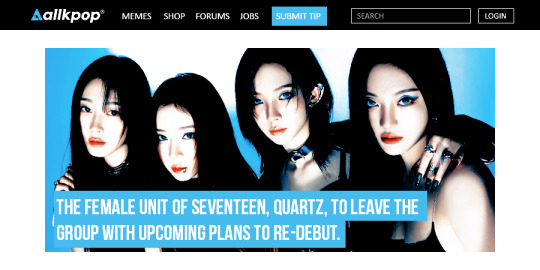

( 💎 ) ⸻ #𝗤𝗨𝗔𝗥𝗧𝗭 𝗡𝗘𝗪 𝗣𝗢𝗦𝗧. ( TW ... misogyny & mistreatment ) BY 99KITSCH, on NOVEMBER 4, 2024.
OLIVE, AIQING, EMI and RAON took to social media in a joint statement this morning to announce their departure from their group, SEVENTEEN. the four female members making up the group's subunit, QUARTZ, have spent the last SIX (6) MONTHS on hiatus due to arising conflict between their companies. their last schedule as SEVENTEEN members was the final day of the FOLLOW TOUR on MAY 26, 2024, in YOKOHAMA, JAPAN. their fanbase, CARATS, started to get concerned with the lack of transparency when QUARTZ missed SEVENTEEN'S performance at LOLLAPALOOZA BERLIN.

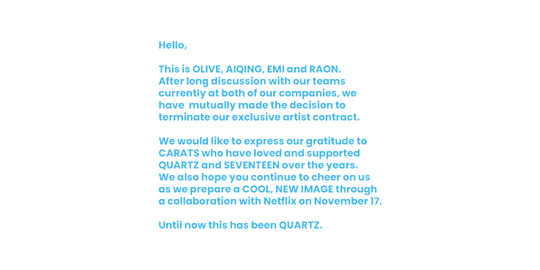

❛❛ Hello. This is OLIVE, AIQING, EMI and RAON. After long discussions with our teams currently at both our companies, we have mutually made the decision to terminate our exclusive artist contract. We would like to express our gratitude to CARATS who have loved and supported QUARTZ and SEVENTEEN over the years. We also hope you continue to cheer on us as we prepare a COOL, NEW IMAGE through a collaboration with Netflix on November 17. Until now this has been QUARTZ. ❜❜
QUARTZ first made their way onto the stage in various pre-debut videos KNOWN AS THE GREEN ROOM from early 2013 - 2015. it was not long before the group stole everyone's hearts with their unique talents upon debuting as individual members of SEVENTEEN. while everything was total bliss at the beginning, it did not take long for the fans to ark up about unfair treatment between the female and male members of SEVENTEEN. QUARTZ UNIT was made to debut to appease the fans with the repetitive discussion of MISMANAGEMENT compounded by their ongoing demand by the general public. every so often when SEVENTEEN or THEIR COMPANY would be in HOT WATERS, QUARTZ coincidentally would be given another comeback. well that is atleast what user @/17211182026 on twitter has theorised relentlessly.



a REPRESENTATIVE from QUARTZ'S COMPANY, STARGIRL announced, " QUARTZ is currently going through a re-brand as they enter a new era at JUPITER RECORDS. " this was followed up with JUPITER RECORDS releasing new official company profiles for the group, with Y2K-stylised pictures heavily inspired by the trend's unexpected return. QUARTZ were previously known for their REFRESHING BLEND of GENRES and CONCEPT but this new move signifies an ever fresher start for the girls as they chose to sign with JUPITER RECORD'S subsidiary, STARGIRL once again. JUPITER RECORDS are yet to comment on whether the members will be adopting the QUARTZ name. however, KNETS sleuths noticed the company applied for several trademarks, suggesting this move has been on JUPITER'S mind all year long.
but that wasn't the only surprising thing this morning. OLIVE reposted a very iconic meme to her INSTAGRAM story with the caption, 'Monday Mood'. this image of NICOLE KIDMAN after finalising her divorce has done its rounds, and NETIZENS are lapping it up, but it appears CARATS are speculating the reasoning behind this post. this comes after a parents of one of the members revealed, "There has been tension going on between companies for quite a while and I think in the end it really impacted the relationships the girls built with the other members. Just from talking to my daughter this past week, I know she will be much happier away from that awful company. Good riddance!". we are looking forward to what OLIVE, AIQING, EMI and RAON reveal in their very first documentary as a group, "DIAMONDS ARE FOREVER!".

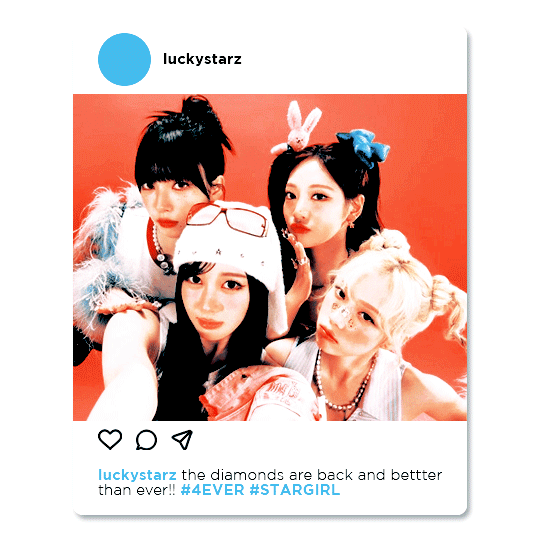


☆ . 𝗰𝗼𝗺𝗺𝗲𝗻𝘁𝘀 !
( +342, -56 ) this is like when zayn left one direction all over again. ( +294, -187 ) OLIVE will always be THAT GIRL !! ( +256, -101 ) OH I know that company is up in flames rn. aww so sad !! ( +243, -112 ) i hope the girls are healing & happy !! ( +215, -76 ) makes me so so sad to think abt how my babygirls will only been known for their male counterparts </3
JOIN THE CONVERSATION && SEND UR THOUGHTS IN

#* ✰ ◞ baby you are my angel — articles#ficnetfairy#fictional idol community#fictional kpop idol#fictional kpop group#idolverse#seventeen addition#svt addition#seventeen added member#seventeen female addition#seventeen oc
31 notes
·
View notes
Text

This was one of the pages from Rebellion Production Note that I spent a lot of time studying when I was writing my big Homulilly essay, and it's kind of embarrassing because I was so focused on Drosselmeyer and the shadow box on the right that I completely missed the significance of everything else on the page. To be fair, at that point, I hadn't watched the Eternal recap movie, so I didn't recognize the end credits in the upper left box, or the salamander filigree in each corner.... but now they jump out at me so vividly and I wonder how I never noticed them before.
As its name suggests, the Production Note contains a lot of images from the production process that never made it into the final draft, but I have to say that the suggestion that the Eternal end credits are playing out on Homura's "stage" (capped with a salamander, no less) makes my jaw drop, especially since it's only visible in this "zoomed out" sketch. It also makes the similarities between this and the framed Nightmare portrait/stage (which I'd noted in the post linked above) even more obvious... they really are the same stage!
In the finished film, we also get a closer look at the shadow box section, which shows a variety of symbols, including the goblet holding Homura's soul gem in the real world. Now this is where things get interesting, because its inclusion makes perfect sense on a non-diegetic level (i.e., as foreshadowing of what's to come), but begs the question how did Homura "know" to include it?
There are two possible answers to this question and they are not mutually exclusive:
Homura is subconsciously aware of her situation, and thus these elements appear in her world even without her direct knowledge.
Rebellion is a story staged by someone (presumably Homura, though there's at least one other possible candidate) after the fact, just like we see in the Production Note with the Eternal end credits (which are narrated by a witch because of all of the witch runes).
In addition to the goblet, there's also 3 different kinds of flowers, a butterfly, a key, a match stick, a grief cube, a syringe, an equestrian on a horse, a bagel/doughnut, a record, a blimp, and what appears to be a man wearing a woven straw raincoat. I'm not sure about the last one, but most of the others appear somewhere in the movie, so they probably all mean something to Inu Curry even if it's not obvious to me at the moment.
The text to the left reads "Owari", meaning "the end".... both in the sense of the end of a story and the end of a life, in keeping with Rebellion's twin fascinations of storytelling and suicide. Also note the lace curtains on the bottom of the lefthand "stage," with runes identifying Homulilly, plus the red yarn that encloses Hitomi when the Nightmare takes over.
Also, I notice that Drosselmeyer is dressed very brightly, like a fool or a jester, in keeping with his role as an entertainer. I wonder about the medals pinned to his chest and what they mean.
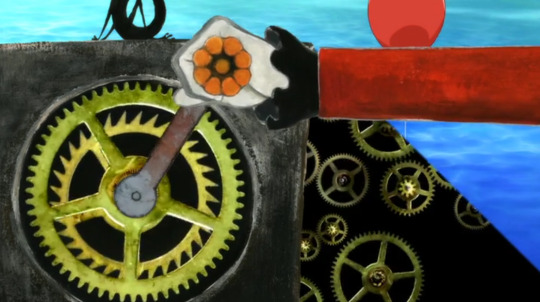
In the movie, the shadow box works by turning gears... and for a moment, you can see the world turning behind the machine as we literally glimpse what's behind the "curtain". As in the Production Note, the salamander is on top.
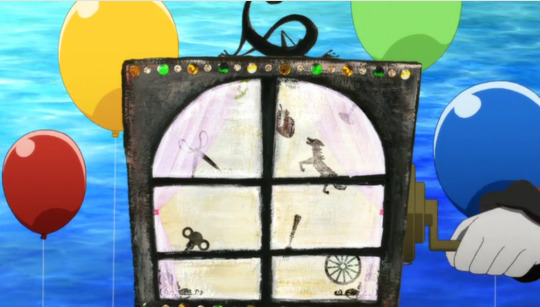
View of the stage from the front. Note the curtains on the inside, and the window shape. Among other things, there are scissors, a horse, and a wheel.
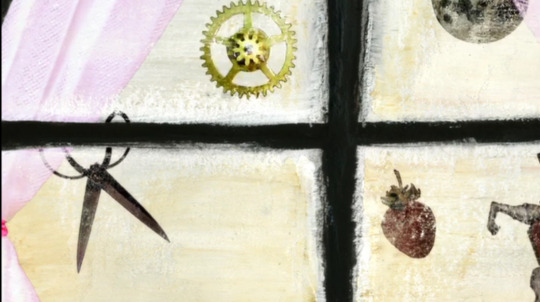
Close-up showing a falling gear (like the snowflakes that will come later), the moon, and a lump that appears to be a strawberry.

Wide shot showing that the stage on the left in the Production Note is the version that made it into the finished film. Even without knowing anything about who these characters are, you can tell they don't belong because they don't match their surroundings.... they are literally drawn in a different style.
Suffice to say that this scene in the film, combined with the additional details from the Production Note, makes it clear what Inu Curry thinks is going on here... which has some tantalizing implications going forward.
26 notes
·
View notes
Text
look LOOK ok i was joking before but the more i think about it the more real Ms Flood being Iris/an Iris Wildthyme expy is to me like I've fully convinced myself at this point.
like i have SUPPORTING EVIDENCE it MAKES SENSE to me. its not gonna happen but also after that fucking finale i am willing to believe anything...
FIRST of all RTD took so much stuff from the books during his first run, including having River as she is originally written as a Bernice expy (proof he would take characters from extended universe media) and the whole time war coming straight from the eighth doctor adventures (proof he would take inspo from the EDAs). THEREFORE....iris originally being from the EDAs means shes within his purview. so its not impossible and im not TJLCing myself and you cant accuse me of such
point number two -> i think her introductory book (Scarlet Empress) has a lot of thematic resonance with this first season re: all the stuff about stories, narrative, audiences, observation, etc. been a while since i read it so its not as fresh in my mind but theres a Lot going on in that book about stories, and about the form of Doctor Who itself, about it being a cyclical, self-referential thing that endlessly iterates on itself. iris literally retcons herself into the doctors life by telling him about adventures theyve gone on together that he swears never happened, until he finds himself remembering them. the story comes from the POV of an unknown and unseen audience going through her various recordings and writings of the events. reality is created from fiction. reality is made slightly more fictional. the artifice of the Entire Series isnt necessarily addressed, but is sort of gestured at with nodding and eyebrow wiggling. all in all, very fitting, i think.
and as for what we've seen of Flood so far we can certainly check off addressing the audience, being rude in a familial sort of way, boozing it up, knowledge of TARDISes, and swag fur coat outfits. also VERY much of note is her suitcase covered in travel stickers of places the Doctors been, which is again totally in line with how Iris is written in Scarlet Empress, existing in a sort of parallel, not-quite-mutually-exclusive canon where she was the one who did all of the big things the doctors done, while acknowledging that he has also been responsible for the exact same events. and if you really want to get crazy you can take the Prominent Old-Style Double Decker Bus with Suspicious Numbering in that one post-apocalyptic scene in the Devil's Chord.
anyways if anything happens that could even make it look like im a tiny bit right i will become unmanageable.
24 notes
·
View notes
Text
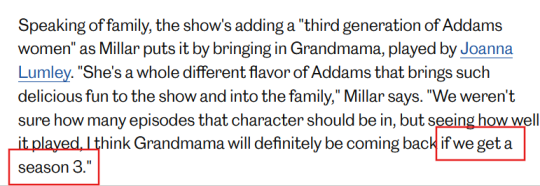
So now the writers AND Jenna have stated that S3 is not guaranteed.
I feel like some were hoping that Tudum's big Wednesday announcement was that they greenlit S3, but it was just a performance by Lady Gaga and they named her character (Rosaline Rotwood).
Then there was this anon gem from 4 Feb 2025.

I think a lot of us need to admit that we simply do not know how the business works and what those notices actually entail. Clearly the filming date and the production notice were NOT indicative of S3 being greenlit.
It's ok to admit you don't have the information and don't know something, otherwise time will turn you into an ass, like the douchebag anon.
I think people are mistaking popularity with a guarantee to be renewed. It's not just about popularity, it's about making money. For Netflix, this is mutually inclusive.
It's like with Jenna. Is she popular, yes. She has a large following and she produces a lot of buzz/comments on social media. Does she make money? Well...the box office says no.
I think her recent box office failures are likely considered, not the deciding factor but considered, in why Netflix is likely awaiting S2 to premier and the numbers.
If I were Netflix, I'd be nervous that the star of the show simply isn't pulling in money for her other projects like everyone hoped.
It's my understanding that for big productions like Wednesday with special effects and specialized costume/set design (in addition to a bloated cast), they have to have a lot of views AND there has to be new subscribers. That's what is part of Netflix's mystic algo that gives the show the greenlight. New subscribers are how they profit.
Shadow and Bone was also very popular, but they still waited for the numbers of S2 before they decided to cancel the show.
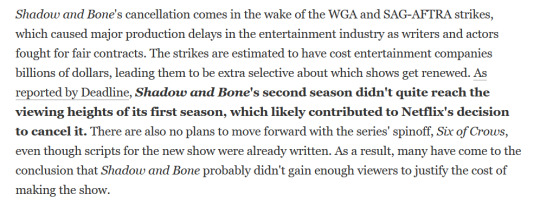
I will not be adding to the viewership numbers for Wednesday S2 when it premiers. I'm doing this for a several reasons.
While PHW has been nothing but gracious and professional in the face of everything that's happened to him, I do not know if Netflix did right by him behind the scenes. They have until August to reveal that, but until they do then Wednesday S2 will not get my viewership.
Netflix is pulling some BS by splitting it up into 2 parts. I am not playing their silly games, the same goes for the final season of Stranger Things. I'm patient, I can wait until the full seasons are out and where my view will not count.
I truly believe Jenna, Emma, and the rest of the cast are over Wednesday. Jenna has gone on record several times of how Wednesday fame has been bad and alluding to how Wenclairs are fuckasses, and the whole cast seems totally lukewarm and unenthusiastic. Emma has also alluded to Wenclairs being fuckasses.
Jenna has also admitted to playing a schoolgirl feels like it's holding her back. She wants to be taken seriously and I think she knows it means that she can't keep playing Wednesday Addams.
They all seem ready to move on, so I will help them out by not contributing to numbers that might make the series drag on. Most of them have bigger and better things to do honestly. I see not adding to viewership as helping set them free.
If S3 does get greenlit, then I hope the very best for the cast and that they all get big pay raises.
#percy hynes white#wednesday netflix#jenna ortega#emma myers#hunter doohan#georgie farmer#joy sunday#miles millar#alfred gough
6 notes
·
View notes
Text
Two Things Can Co-exist!
Why are people so easily falling into the trap of Supporting Palestine/Palestinian rights = Antisemitism?
We can, and do, support Israel's rights to exist, protect itself and its people, and we can do also support Palestine's right to exist. These are not mutually exclusive positions.
It is also not antisemitic to criticise a Government or Military engaged in Genocide - which the most right-wing elements of both in Israel are doing.
Hamas, Palestinian Jihad and the other groups like them are terrorists and should be brought to justice. But that cannot include what is currently happening - The Collective Punishment of Gazan-Palestinians. The IDF keeps showing it's capable of precision attacks, yet also keeps telling us it needs to thoroughly clear out Gaza to defeat Hamas.
'Bibi' as he's so affectionately called by right-wing press these days, is on record opposing the Two-state solution, he's teamed up with the 'Ultra-zionist' right wing (which wants to create Greater Israel which would stretch from Suez to Turkey's border)..
You're damn right I'm going to call a Fascist a Fascist. Benjamin Netanyahu is a Fascist, relying on Fascist support, to commit a genocide in Gaza.
That's not being Antisemitic to say. Two groups of Fascists (Hamas, and Netanyahu's cabinet) are fighting each other, with Israelis and Palestinians playing in blood.
Both Israel and Palestine have their rights to exist, protecting themselves and their people.
Don't blame Jewish people. Don't blame Palestinians. Blame Hamas, blame 'Bibi' and his fascist cohorts. Blame Iran's funding and equipping of terrorist groups. Blame the Settlers.
Learn set theory.
2 notes
·
View notes
Text
Vampires, Part 2: Dracula and the Neoclassicals
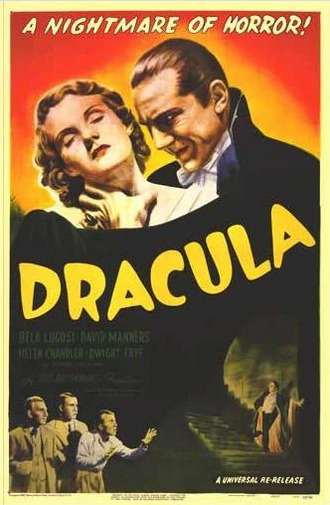
Below the cut, The Pedant turns its eye to the typical Vampires of most modern worlds - Dracula, and the Common Post-Stoker Vampire. Read on to discover the taxonomy of the Neoclassical Vampire.
No taxonomy of the Vampire can begin without due regard to the 'father of vampires', Dracula. The immortal Impaler, transformed for his bloodthirsty sins into the first or perhaps greatest of his kind, is a recurring motif among the vampire specimens of the Anthropophilic Universes. Sometimes this Dracula is closely related to the historical figure, but more frequently the relationship is strictly nominal. This is perhaps fortunate, as the Pedant has already recorded the historical Vlad Dracula as Homodraco homodraco subsp. dracula - a taxon we will not be changing, as it is clear from the gentleman's name that he was a member of a Draconic lineage that simply, through convergent evolution, resembled Homo sapiens. The draconic status of Dracula has also produced some theories that the vampiric condition is in some way linked to Dragons - a thesis that the Temple's various camps all firmly reject, as it is wholly unevidenced.
Turning to the Vampiric Dracula now, we find in him an elegant type species of the common or 'neoclassical' vampire - not the earliest known description, but certainly the best known. The common vampire is distinguishable from the family of classical protovampires and the more divergent post-Stoker vampires, though it combines certain elements of the former and is largely responsible for the enduring presence - thanks to the well known Universal Ripple Effect of particularly prominent descriptions - of Common Post-Stoker Vampires in other realities.
Dracula and his cognates are immortal beings, originating from a single ancestor cursed by God, who exhibit obligatory and exclusive haemophagia, non-exclusive nocturnal habits, the complete cessation of ordinary metabolism, enhanced senses, and several characteristic supernatural characteristics. They are driven into a largely involuntary slumber during the day, vulnerable to sanctified objects and symbolism, and unable to freely cross running water - negative manifestations of their curse that are balanced by the ability to manipulate the weather, shapeshift into mist and various night creatures (and to control such creatures), and to walk the spaces inbetween. They create further vampires through feeding, with a non-obligatory mutual exchange of blood in Dracula that, in the common post-Stoker vampire, becomes largely necessary.
This, then, is description of the 'neoclassical vampire' type specimen. It is stable, it recurs, and it is capable of reproduction. The tripartite test is fully satisfied, though before we proceed to a formal taxonomization, we must also consider the etiological agent. In the case of Dracula, no specific agent is known - it may only be inferred that it was the product of a combination of black sorcery and divine curse - while in the case of many neoclassical vampire successors, including several Dracula successors, the origin is rendered an explicit divine curse. As this curse is transmissible, we consider it an appropriate subject for nomination as well, and will venture a tentative syndrome name for those who reject the validity of exvitus taxonomy.
Accordingly, we nominate Dracula and the close successor neoclassical vampires as follows, with hierarchical taxa, niche taxa, and mythotaxa in order: Corpusdamnatio (sanguophaga) draculii (that is, Draculas of the genus 'Damned Corpses' and subgenus of 'Blood-Eaters'.) Homo damnatus anthropophagus tenebris (or, 'Damned man who eats men in the shadows') Wampyricus neowampyricus alterphobosmetaphoridae (Neo-Vampire as Metaphor for a Fear of Otherness)
We also briefly note that the Corpusdamnatio genus is a broad category of 'damned/unholy' corpses within the broader Animacorpusidae family, tracing back to the Exvitus Superdomain - things that, having ceased to be alive, are in some way altered sufficiently as to constitute new species for taxonomic purposes. The hierarchical taxonomy of the Exvitus superdomain is wholly unconcerned with 'evolutionary taxonomy' as the entities in question are quite dead, and what evolutionary reproduction occurs is usually tied to the causative agent rather than the host body.
Turning now to that causative agent, we find in the neoclassical vampires a fairly standard presentation. The blood-borne agent does not physically exist as microbe, virus, or particle - it is a metaphysical contagion, tied to the act of symbolic bloodshed and the consumption of lives. It is of a divine origin, and so we tentatively nominate it as follows: Spiritoviria (malefactum) necroanimacotes anthropophagicetes haemovorilales dracularidae draculagenitorus, with the specific Dracula strain being Transmissible Vampirism/Human/Transylvania/Stoker/1898, and with the syndrome name of 'Transmissible Human Draculaism Blood-Curse' or 'Type One Transmissible Vampirism'.
We note that Type One Transmissible Vampirism's exact manifestation differs from case to case. Many lack the difficulty in crossing running water, while others lack the ability to transform into mist or bats. In this respect, we may find in Dracula the fullest expression of the curse and the resulting syndrome, and the true type specimen of the neoclassical vampire.
We note that Count Orlok, while commonly believed to be a Dracula, is in fact a wholly distinct variety of entity, more closely resembling the various Demonic Vampires we will consider in a later instalment. In the next instalment, we will consider the 'Cainite' vampire in some detail - they appear to be the fullest flourishing of the post-Stoker common vampire's diversity, but paradoxically, also the high water mark of the neoclassical vampire's seemingly uncontrollable spread through the Anthropophilic Cluster.
#taxonomy of vampires#vampires#vampire taxonomy#fantasy taxonomy#taxonomicon.vampires#dracula#taxonomy with the vampire
2 notes
·
View notes
Note
Heyo :)
Do you have any headcanons about the drama club? (Trevor, Caitlyn, Angela and Joey's drama students?) I just have a thing for characters who don't do anything
The drama students, my babies! I absolutely do, I LOVE THESE GUYS.
Not trying to shoehorn my own fic in here, but they all have huge parts in Call Us Now (my Carrie AU), so I highly recommend that if you wanna see these guys.
Caitlyn:
Pan
Neighbour to Grace
Lowkey crushing on Grace
Hates Ruth and the feeling is mutual
She is convinced Ruth is jealous of them
She also believes that Ruth steals scripts, props and costume pieces because she'll never have any of her own
She is usually cast as the leading lady in the school shows, mainly due to having the higher vocal range over Josie (most female leading parts being mezzo or soprano) and not so much acting ability
Somehow ends up playing the same vaguely southern valley girl every time
(Doesn't have the biggest range)
While she isn't the strongest actor on stage, she is the most musically inclined
The instruments she can play are: piano, guitar, drums, violin, harp, recorder and bassoon
She is in orchestra with Pete and Grace, she plays the violin - she only joined in the hopes of getting to talk to Grace though. She was already in the marching band; she was cool enough to be in it
Cait really loves flowers, currently works at the local florist
Her family's garden has definitely won some small local competition because of how well she keeps it
Her dog, Luigi, usually features as the dog role in the school shows: Toto in The Wizard of Oz, Sandy in Annie, etc. He is Captain in The Barbecue Monologues
Trevor:
Gay
Dating Rudolph for over a year now
He is a hall monitor with Grace but he frequently chickens out of actually telling people off and has a habit of letting them get away with things
If you're planning to cut class and don't want to get a detention for it, you should be in his designated monitor area, not Grace's. The seniors now almost exclusively hide in Trevor's half of the building
Is kinda the newest one to theatre, having started in freshman year
Not great with learning lines, has shown up in the wrong costume and forgotten to pick up his props on multiple occasions
They love him to bits though and happily laugh along with him every time
The embodiment of "he's a little confused but he's got spirit" meme
He and Brooke have been best friends since elementary school
She acts like his guard dog, protecting him from bullies. And he tries help cover up her fires so she doesn't get into trouble
He calls her "a terror" affectionately
Definitely the kid that breaks character onstage to wave at his parents/family/loved ones when he first walks on
He is a very passionate cook
Usually hosts the cast parties after they finish each show and he makes sure that the menu is loosely based off set show, full of jokes and play on words
Josephine (my name for Angela's drama student):
Queer, unlabelled
Caitlyn and Josie are the epitome of the two girls giggling at the back of the classroom
They are literally the Syd and Olivia of Hatchetfield High, if you are familiar with them
(If not, they are Mariah and Angela but we turn that theatre kid energy on max and add a slightly unsettling vibe)
Is the strongest actor of the four but has yet to realise that herself
As second female (and the lower range one at that), her parts are usually less desirable and not as impressive to Cait's
However, she recognises its fault of how musicals are written and casting, rather than her or Cait. So no hard feelings! She thinks Cait is the most amazing thing since spaghetti
Her and Cait really want to be on Broadway together in the same show; preferably as Elphaba and Glinda in Wicked
"Tiny, loud and Italian" to coin a phrase
The only person Trevor will allow in his kitchen and let him help cook
The least chaotic of the four, the sweetest to those outside of the drama club and the nicest one to Ruth... most of the time
Is the best at not cracking in the middle of scene
Went to a ton of those weird theatre classes over summer - she did one specifically on different types of screaming
Transferred from Sycamore in middle school
Goes by almost every possible nickname for her name, but call her Jo or Joey and you will likely get your knee caps bitten off
Kevin (my name for Joey's drama student):
The eldest and tallest in the year
Bi
He is the school's leading male and usually playing the love interest type role to Caitlyn
The two are very awkward when onstage together, kinda hate playing romantic love interests - don't get me wrong, the drama kids are all real close and love each other, these two just find it weird
He'd like to play romantic interests with someone else for a change
Pete has beef with him for no particular reason. Kevin believes it's because he always outshined Pete when they went to dance classes together
Thinks Ruth's name is Rachel and doesn't listen when he is corrected
He also thinks he is the funniest actor of the four of them and really plays up his comedic bits. Or just turns something into a comedic bit
(The amount of tragedies he's turned into comedies is concerning)
It is his personal goal to try make the others break
In spite of all that, he takes his work very seriously and considers himself the most professional performer of the group
Was definitely a Gleek at some point
He is dating Josie
He and Trevor try to sneak a fist bump into every scene they share in all of the shows. Miss Mulberry has yet to catch them doing this
Doesn't actually know which jock is Max, so he just fears all of them to be safe
Hoping this will do for now, but feel free to ask anymore questions!
#mari’s asks#mari’s headcanons#hatchetfield#npmd caitlyn#npmd trevor#npmd joey’s drama student#npmd angela’s drama student#npmd drama students
2 notes
·
View notes
Text

Fresh Listen - Dollar Brand/Abdullah Ibrahim, Peace (Soultown, 1971)
(Some pieces of recorded music operate more like organisms than records. They live, they breathe, they reproduce. Fresh Listen is a periodic review of recently and not so recently released albums that crawl among us like radioactive spiders, gifting us with superpowers from their stingers.)
There exists so much fucking music on this earth. It is the most appropriate medium by which to express joy and pain; as long as there have been people, there has been music. And despite it’s ever-presentness, messy crossbreeding, the ubiquity of its favorite topics (unrequited desire, unmitigated want, the unfairness of love, the unfairness of man) it never ceases to amaze me that this constantly evolving relic of the corrupt human heart can still come across as innovative, refreshing, shining new lights on what we never realized were the darker pockets of our souls.
I’m so in love with music that I find myself mostly neutral to bad music, unless it is very, very bad. Not bad as in raw or unrehearsed, but as in overcooked, predetermined, calculated. I can not only appreciate, but have found myself swept away by, pop at its most mainstream, and when come across a style or genre of music that doesn’t suit me, I blame it on the limited powers of my own tastes, rather than the music itself. Bad music to me is soulless and algorithmic, a pushy scam in which sales or some other sad notoriety are the end goals, not any kind of genuine expression. For some, those who are more agnostic about the function of music, the zombified facsimile comprises the baseline. It’s a tragedy, but I suppose there are also people who prefer Olive Garden or Applebee’s as destination eating. I know I’m a fucking snob. And yes, to each their own sustenance, but there exists a universe of beauty and liberation that cannot be spoon-fed, that must be discovered on its own terms.
At one point, and in rare cases today, making good money and making good music weren’t mutually exclusive. In fact, songs that gained traction in the popular consciousness and became hits were often assumed to have artistic pedigree, a stamp of quality. Writers, artists and producers had taste and restraint. Consider the minor hit “On My Own” by Patti LaBelle and Michael McDonald, or as the great musician reminded us in the last set of the 2024 Newport Jazz Festival, Nile Rodgers, whose contributions over the past fifty years—with his own band Chic, and David Bowie, and Madonna, and Daft Punk. There were once artists who elevated the primitive discourse of pop music. Nowadays, the visionary songwriter/performer is the exception, not the rule, and the industry seems mostly run by technicians who Frankenstein kitchen-sink musical ideas from once living threads of thought and passion into something uncanny and undead.
Nevertheless, out of the great universe of music, I believe 90% of it is good. And, to me, there is a 95% subset within that 90% that is great or better than great. The tragedy is, I’ll never have the chance to hear most of it. To paraphrase Cormac McCarthy’s judge from Blood Meridian, there is far more that exists in this world that we don’t know than we know.
So I dig. Look at what’s placed face forward on the walls of record stores, or in the discount bins, in the odd thrift store, what’s being written about by whom and in what publication, what my music streaming service recommends via algorithm, based on eerily accurate aggregate data tied to my presumed interests. While digging is a worthy pursuit, it can kill chunks of a day, since music is only activated by the passage of time, compounded by the amount of time it takes to wrap one’s head around a certain piece, to qualify it. Especially if the music is challenging, which usually leads to greater rewards for the listener. It’s a significant investment, but it pays. Our soul grows while our life span shortens. At least there is joy.
The shortcut to music discovery, and the one that turns me on the most, is the recommendation from a friend. Not any friend, but one whose taste in songs you trust, who has rarely guided you to the mediocre, the cheap shit, whose recommendations are sparing and swamped in mystery, devoid of explanation. This is how Dollar Brand/Abdullah Ibrahim’s 1971 album Peace found me, featuring Ibrahim on piano with two other players: Victor Ntori on bass, Nelson Magraza on drums.
There was just a link to the album via text, sent by my friend Tommy in Portland. No description, no context. When I was in Ukraine as a Peace Corps Volunteer from 2004 to the end of 2006, Tommy helped me maintain a baseline of sanity by mailing me dozens of burned MP3s, which included, along with obscure releases from psychedelic folk outfits of the 1960’s, scratchy reissues that seemed to have been digitized from the turntable to the computer, and the albums of contemporary bands that were gaining some traction in well-regarded music publications of time (the indie rock/freak folk boom of the early aughts). I devoured these records incessantly. I played them loud in my apartment in Mykolaiv, through a small boombox that could, miraculously, read MP3 files; over the warm summer months, drinking Yantar with the windows open, the breeze lifting the lace curtains of which the Ukrainians were so fond, and during the dark afternoons of winter, wearing my coat in bed while I read. I find myself filled with a clammy horror when I consider how bereft my life would have been in that apartment without the boombox and thevMP3s, hundreds of songs. It changed everything, it made everything better.
Going back to Peace. Tommy knew that I’d lately (at least within the past ten or so years) moved away from the rock bands of our youth to jazz musicians, and he was on his own trip into the genre. (Tommy is the kind of artist who once wrote a song called “Jazz Is Waiting” to acknowledge that frontier of unexplored sound, from the perspective of a dyed-in-the-wool singer-songwriter.) Looking at the thumbnail of the album’s cover in my text messages, I wondered, “Why this album? Why now? What is trying to be said here?” And when I listened, all became apparent.
Ibrahim’s album begins with his version “Shrimp Boats,” an IYKYK jazz standard based on a peculiar pop tune. In Ibrahim’s hands, the tune should be recognized as one of the masterpieces of recorded jazz, alongside equally beautiful tracks such as "Forest Flower: Sunset" by Charles Lloyd, or "First Light" by Freddie Hubbard or "Flight Time" by Donald Byrd. It begins, romantically, as a classical love ballad, before its tine shifts to the brief mantra of a prayer, Ntori’s bass weaving a firm bottom end to support Ibrahim’s vigorous chords. Then, with great flair and drama, Ibrahim fingers the piano keys in such a way as to transport the entire performance into an energetic exercise of happy explorations with his right hand, while his left hand ensures we are safely enveloped within a stable means of conveyance as he rhythmically rubs the backbone of the song. The improvised combination of freedom and control is played with such intention that it never seems repetitive over its eleven minutes of playing time.
I can’t help but compare Ibrahim’s piano playing style with Monk’s, at least, in terms of the vitality with which both men play. Both musicians aim high for beauty and invention, but whereas Monk comes at those qualities at an angle, Ibrahim grapples with it in a more straightforward, almost orchestral way. There is less of an intellectual proposition in Ibrahim’s “Shrimp Boats” than you would find in a Monk performance.
The point of “Shrimp Boats” is transcendence. A transcending of melodic circumstances through the identification of a thread of deeper meaning behind those circumstances, the acknowledgement that every moment is weighted with significance. Although most of us humans lack the capacity to invest full powers of our attention and contemplation on every moment of our lives, it is worthwhile to sometimes try. We flail for survival—“Shrimp Boats” reminds me of how complicated everything is, and in verse after verse Ibrahim makes the case for carrying forward such moment-to-moment awareness, breaking down enormous possibilities into actionable propositions.
When I first listened to the song, I was walking a series of twenty-four flights of stairs, with weights, as part of my exercise regimen. Ibrahim and his band kept pushing me upwards, sweaty and exhausted as I was, toward the clean terminus of his finished thought. I realized the world is overwhelmingly beautiful, even when seen from a prison of a concrete stairwell, each landing offering a more diminished view of the Ala Wai Canal and the apartment towers that line it.
“Salaam (Peace)” is a brief bit of meditation through heavenly chords before the electrified jaunt into “Cherry,” where Ibrahim rocks the piano with a Vince Guaraldi-esque gusto and sense of play. The piece wouldn’t seem amiss on a Peanuts special, with Lucy and Pigpen doing their thing, groovily, while the piano is ringing.
Though it almost seems like a twelve-minute exercise in endurance, Ibrahim and his combo endlessly fascinate in “Tintinyana.” The song is essentially a brief musical line, repeated ad nauseum, and Ibrahim harmonically deconstructs the sequence while remaining true to the song’s time-based foundation, adding a warm, colorful flesh to a skeleton of a tune. What would come across as dead and immobile from a lesser artist Ibrahim, inspired to invention, improvises to life, thrusted forward by bass and drums, finding in each run a new means to say his piece from one transition to the next.
After the reflective “Just a Song,” Ibrahim swings right into “Little Boy,” setting up a looser, more laid-back groove. At two minutes it is a new kind of center for the record, spiritually easy-going, nodding to a higher power while letting it all hang out. Despite the brevity of “Little Boy,” Ibrahim continues to make little discoveries through repetition. “Little Boy” is a suitable coda that calls back to the aesthetics of the band established earlier on the record. It eases the listener to the next level, where all that has gone before floats away, becomes more feeling than music.
2 notes
·
View notes
Note
Still bored?
If so
Ramble to me about why u like malevolent (and like the plot and stuff)
I love it when my friends (and mutuals) infodump
omg yeah ofc!!! I'm not bored anymore but I love any opportunity to share something I'm interested in :)
so basic plot line of malevolent bc i feel like the blurb you find online doesnt do a good enough summary: Local Detective (Arthur Lester) Loses Eyesight To Potentially Evil Entity (Later Known As John Doe) Which Killed His Detective Partner And Now Must Go On The Run From The Cops While Solving A Cold Case From Years Ago And Avoiding Eldritch Horrors Along The Way
its honestly pretty scary, like much more scary than tma, but i got used to it pretty quick. anyways, i digress. some things i love about this podcast:
the soundscaping is INCREDIBLE. like listen to this podcast with the best pair of headphones you own bc you will feel like you actually are arthur lester with a lil demon man whispering in your ear, and you can almost pinpoint the direction and distance of the sounds you're hearing!
also the concept of it is brilliant! john doe eventually ends up acting as arthur’s eldritch seeing eye dog and describes everything he sees, which is a totally fascinating concept. when you start a podcast, you are, in essence, blind, so to have a narrator describing everything you see as the main character explores a new environment is very clever
I also love the overall message of this- exploring what the definition of humanity is in the most brutal and bloody circumstances. it's about how loss shapes us and breaks us and how the things we love make us whole. it's heartbreaking and grieving and hopeful and beautiful all at the same time and I love it!!
also this podcast is made by JUST ONE GUY. all one guy!! he does the writing, recording, voice acting, soundscaping, producing, composing, you name a part of podcast production and this man has done it!! while this does have its own issues (episodes come out once in a blue moon, the cast is almost exclusively male characters, etc), harlan guthrie is an absolute mad lad for producing a podcast of this scale and quality all on his own!! I'm so impressed!!
anyways, all this is to say that malevolent has me fully hooked and I cannot wait to find out what happens next :))
7 notes
·
View notes
Text
The Steroid Olympics
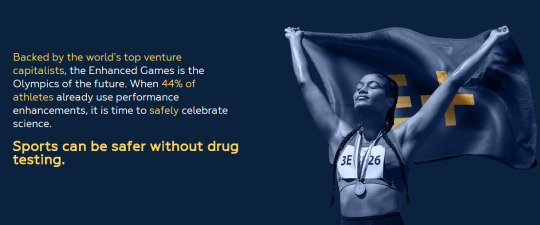
There's been some talk floating around online lately about The Enhanced Games, including an episode of the Trashfuture podcast I'd certainly recommend.
I've become fascinated--not because I'm a right-wing tech-and-immortality fetishist, but rather because of the specific and insidious way the project uses progressive language to hide its true nature. It's evil in a fascinating and specific way that leans on progressive language to do its dirty deeds.
First, I should explain the project. "What if the Olympics let every athlete do as many steroids as they want?" is the basic pitch. Going deeper, it's part of a certain subset of global capital's fascination with what's called here Human Enhancement: the search for immortality and transcendent physical power. It's also, importantly, a project trying to justify itself and in doing so get rid of the stigma around steroid use in sports (notably not the stigma around steroid use in, you know, HRT.) Also it's a for-profit project co-founded by a pharmaceutical CEO whose companies specialize in Human Enhancement fare.
Look at the tiles on the website:


Pay the athletes. Science is real. Enhanced inclusive language. We'll absolutely look deeper, but there's already a very present sense of what a good friend of mind called crypsis.


There's an almost convincing facsimile of progressive language here. But the tiger is lurking in the grass.
Let's enter some of these tiles. See how a camouflaged predator works.

This is immediately insidious. There's a rhetorical conflation between antivaxxers and anyone who opposes to doping here. And remember, this organization is selling the fantasy of "what if athletes juice so hard they were superhuman."
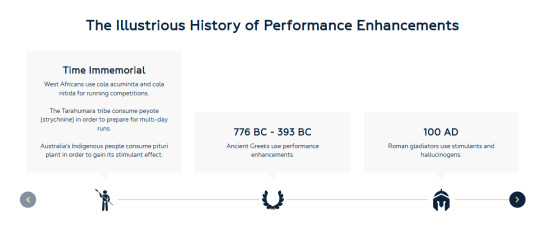
And then we get into the sloppy propaganda-history. It's a lineage more wrenched into place than discovered, and that makes no distinction between war, bloodsport, and sport in a more modern sense.

Bufotenin (not bufotein) is the DMT-anolouge you get from licking toads. Perhaps not the same, conceptually, as anabolic steroid use.
Moving on from the bad history, we have this:

Cherry picking science, in addition to simple lies. Remember, this is The Steroid Olympics. "When used properly" is mutually exclusive with "this is a sports body that gives prizes for every world record you set", right? No matter how much this talks about safety, the basic structure is unsafe for players. And to be clear, steroid abuse of the sort these games are about is *extremely* bad for you. Ringmaster: Vince McMahon and the Unmaking of America by Abraham Josephine Riesman, the excellent history of Vince McMahon and the Word Wrestling Federation, spends many a word on the awful ramifications of widespread steroid use in the WWF. Use of the kind that's necessary to become "superhuman" in the way this site sells is tremendously dangerous, and the site cherry picks research to hide this.
However, this part isn't the most egregious.
The crypsis, the hiding in the grass, becomes central in the Enhanced Inclusive Language portion.

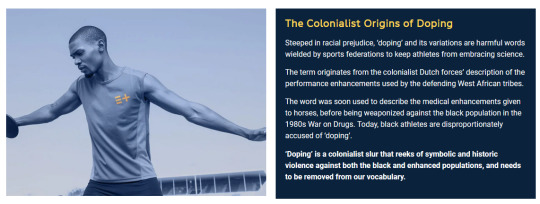
This is the kind of thing that would go viral on here maybe 10 years ago. A single deprecated theory on etymology being sold as the primary one to create a specific narrative. The word "dope" does, in fact, come from the Dutch. However, per the Wall Street Journal:

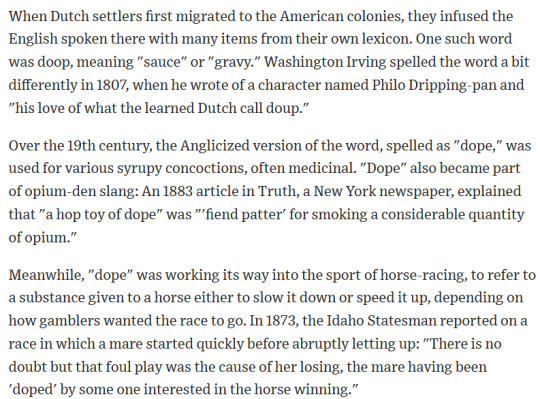
Notice also the "black athletes are disproportionately accused of doping." This is, by all accounts, true. But the issue there is pretty clearly not that doping is illegal. It's racism. And racism that would not be addressed by changing the language around doping.
This will continue in the next post:
7 notes
·
View notes
Text
SPIRITUALITY IN ISLAM: PART 2: THE ORIGIN
As the history of Islamic religious sciences tells us, religious commandments were not written down during the early days of Islam; rather, the practice and oral circulation of commandments related to belief, worship, and daily life allowed the people to memorize them.
Thus it was easy to compile them in books later on, for what had been memorized and practiced was simply written down. In addition, since religious commandments were the vital issues in a Muslim’s individual and collective life, scholars gave priority to them and compiled books on them. Legal scholars collected and codified books on Islamic law and its rules and principles pertaining to all fields of life. Traditionists established the Prophetic traditions (hadiths) and way of life (Sunna), and preserved them in books. Theologians dealt with issues concerning Muslim belief. Interpreters of the Qur'an dedicated themselves to studying its meaning, including issues that would later be called “Qur'anic sciences,” such as naskh (abrogation of a law), inzal (God’s sending down the entire Qur'an at one time), tanzil (God’s sending down the Qur'an in parts on different occasions), qira'at (Qur'anic recitation), ta'wil (exegesis), and others.
Thanks to these efforts that remain universally appreciated in the Muslim world, the truths and principles of Islam were established in such a way that their authenticity cannot be doubted.
While some scholars were engaged in these “outer” activities, Sufi masters were mostly concentrating on the Muhammadan Truth’s pure spiritual dimension. They sought to reveal the essence of humanity’s being, the real nature of existence, and the inner dynamics of humanity and the cosmos by calling attention to the reality of that which lies beneath and beyond their outer dimension. Adding to Qur'anic commentaries, narrations of Traditionists, and deductions of legal scholars, Sufi masters developed their ways through asceticism, spirituality, and self-purification in short, their practice and experience of religion.
Thus the Islamic spiritual life based on asceticism, regular worship, abstention from all major and minor sins, sincerity and purity of intention, love and yearning, and the individual’s admission of his or her essential impotence and destitution became the subject matter of Sufism, a new science possessing its own method, principles, rules, and terms. Even if various differences gradually emerged among the orders that were established later, it can be said that the basic core of this science has always been the essence of the Muhammadan Truth.
The two aspects of the same truth the commandments of the Shari'a and Sufism have sometimes been presented as mutually exclusive. This is quite unfortunate, as Sufism is nothing more than the spirit of the Shari'a, which is made up of austerity, self-control and criticism, and the continuous struggle to resist the temptations of Satan and the carnal, evil-commanding self in order to fulfill religious obligations. While adhering to the former has been regarded as exotericism (self-restriction to Islam’s outer dimension), following the latter has been seen as pure esotericism. Although this discrimination arises partly from assertions that the commandments of the Shari'a are represented by legal scholars or muftis, and the other by Sufis, it should be viewed as the result of the natural, human tendency of assigning priority to that way which is most suitable for the individual practitioner.
Many legal scholars, Traditionists, and interpreters of the Qur'an produced important books based on the Qur'an and the Sunna. The Sufis, following methods dating back to the time of the Prophet and his Companions, also compiled books on austerity and spiritual struggle against carnal desires and temptations, as well as states and stations of the spirit. They also recorded their own spiritual experiences, love, ardor, and rapture. The goal of such literature was to attract the attention of those whom they regarded as restricting their practice and reflection to the “outer” dimension of religion, and directing it to the “inner” dimension of religious life.
Both Sufis and scholars sought to reach God by observing the Divine obligations and prohibitions. Nevertheless, some extremist attitudes occasionally observed on both sides caused disagreements. Actually there was no substantial disagreement, and it should not have been viewed as a disagreement, for it only involved dealing with different aspects and elements of religion under different titles. The tendency of specialists in jurisprudence to concern themselves with the rules of worship and daily life and how to regulate and discipline individual and social life, and that of Sufis to provide a way to live at a high level of spirituality through self-purification and spiritual training, cannot be considered a disagreement.
In fact, Sufism and jurisprudence are like the two schools of a university that seeks to teach its students the two dimensions of the Shari'a so that they can practice it in their daily lives. One school cannot survive without the other, for while one teaches how to pray, be ritually pure, fast, give charity, and how to regulate all aspects of daily life, the other concentrates on what these and other actions really mean, how to make worship an inseparable part of one’s existence, and how to elevate each individual to the rank of a universal, perfect being (al-insan al-kamil) a true human being. That is why neither discipline can be neglected.
Although some self-proclaimed Sufis have labeled religious scholars “scholars of ceremonies” and “exoterists,” real, per-fected Sufis have always depended on the basic principles of the Shari'a and have based their thoughts on the Qur'an and the Sunna. They have derived their methods from these basic sources of Islam. Al-Wasaya wa al-Ri'aya (The Advices and Observation of Rules) by al-Muhasibi, Al-Ta'arruf li-Madhhab Ahl al-Sufi (A Description of the Way of the People of Sufism) by Kalabazi, Al-Luma’ (The Gleams) by al-Tusi, Qut al-Qulub (The Food of Hearts) by Abu Talib al-Makki, and Al-Risala al-Qushayri (The Treatise) by al-Qushayri are among the precious sources that discuss Sufism according to the Qur'an and the Sunna. Some of these sources concentrate on self-control and self-purification, while others elaborate upon various topics of concern to Sufis.
After these great compilers came Hujjat al-Islam Imam al-Ghazzali, author of Ihya’ al-‘Ulum al-Din (Reviving the Religious Sciences), his most celebrated work. He reviewed all of Sufism’s terms, principles, and rules, and, establishing those agreed upon by all Sufi masters and criticizing others, united the outer (Shari'a and jurisprudence) and inner (Sufi) dimensions of Islam. Sufi masters who came after him presented Sufism as one of the religious sciences or a dimension thereof, promoting unity or agreement among themselves and the so-called “scholars of ceremonies.” In addition, the Sufi masters made several Sufi subjects, such as the states of the spirit, certainty or conviction, sincerity and morality, part of the curriculum of madrassas (institutes for the study of religious sciences).
Although Sufism mostly concentrates on the individual’s inner world and deals with the meaning and effect of religious commandments on one’s spirit and heart and is therefore abstract, it does not contradict any of the Islamic ways based on the Qur'an and the Sunna. In fact, as is the case with other religious sciences, its source is the Qur'an and the Sunna, as well as the conclusions drawn from the Qur'an and the Sunna via ijtihad (deduction) by the purified scholars of the early period of Islam. It dwells on knowledge, knowledge of God, certainty, sincerity, perfect goodness, and other similar, fundamental virtues.
Defining Sufism as the “science of esoteric truths or mysteries,” or the “science of humanity’s spiritual states and stations,” or the “science of initiation” does not mean that it is completely different from other religious sciences. Such definitions have resulted from the Shari'a-rooted experiences of various individuals, all of whom have had different temperaments and dispositions, and who lived at different times.
It is a distortion to present the viewpoints of Sufis and the thoughts and conclusions of Shari'a scholars as essentially different from each other. Although some Sufis were fanatic adherents of their own ways, and some religious scholars (i.e., legal scholars, Traditionists, and interpreters of the Qur'an) did restrict themselves to the outer dimension of religion, those who follow and represent the middle, straight path have always formed the majority. Therefore it is wrong to conclude that there is a serious disagreement (which most likely began with some unbecoming thoughts and words uttered by some legal scholars and Sufis against each other) between the two groups.
When compared with those who spoke for tolerance and consensus, those who have started or participated in such conflicts are very few indeed. This is natural, for both groups have always depended on the Qur'an and the Sunna, the two main sources of Islam.
In addition, the priorities of Sufism have never been different from those of jurisprudence. Both disciplines stress the importance of belief and of engaging in good deeds and good conduct. The only difference is that Sufis emphasize self-purification, deepening the meaning of good deeds and multiplying them, and attaining higher standards of good morals so that one’s conscience can awaken to the knowledge of God and thus embark upon a path leading to the required sincerity in living Islam and obtaining God’s pleasure.
By means of these virtues, men and women can acquire another nature, “another heart” (a spiritual intellect within the heart), a deeper knowledge of God, and another “tongue” with which to mention God. All of these will help them to observe the Shari'a commandments based on a deeper awareness of, and with a disposition for, devotion to God.
#allah#god#islam#muslim#quran#revert#convert#convert islam#revert islam#revert help#revert help team#help#islam help#converthelp#how to convert to islam#convert to islam#welcome to islam#hadith
3 notes
·
View notes
Text
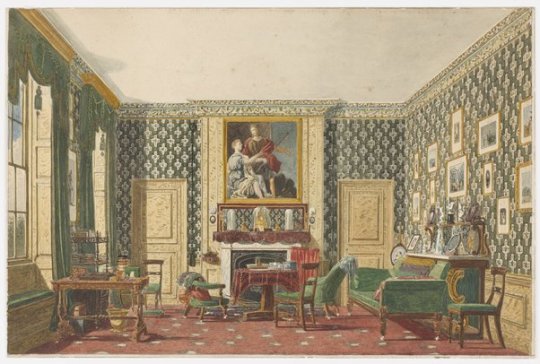
In the mid 2000s, there was a Romantia revival that started from the em-ee-en in the MissMartindale Yahoo group wanted to be involved in the type of lifestyle Miss Martindale lauded in the pre-Bridgehead era.
They successfully hosted several meetups that seemed to initially include a few Aristasians that were left in the Yeek. Unfortunately, this group was, without a doubt, inhabited by at least one far-right fascist (and where there's one...). These types of counter-culture groups tend to attract opportunistic fascists, and Aristasian's unwavering dedication to outright ignoring Tellurian politics did them no favors in this case. They had their own yahoo group called Reality Dawns, and it's interesting to note that the first post is by an Aristasian who gave them some advice to start their community from scratch (and also attempted to distance Aristasians from their doings). This is interesting because it very plainly lays out, in few words, how Aristasians built their subculture. The following is that post:
Greetings. I suppose it would be usual for the founder or one of the founders of a group to write the first message. However, since this does not seem to have happened, it may be appropriate for an Aristasian to do the job. Let me begin by saying that although www.aristasia.co.uk is given as the "further information" address, this group was not founded by Aristasians and does not have the sanction of the Aristasian Embassy. Indeed, it is not the function of the Embassy to authorise non-Aristasian organisations of any sort. As a matter of fact, we do not even know who the founders of this group are - though we might hazard a guess! I mention this merely in order to set the record straight and to avoid any possible confusion that might otherwise arise. There has been some discussion among Aristasians of late about the question of what form a non-Aristasian (presumably mixed-sex) secessionist movement might take. There are a variety of problems confronting such a movement which would have to be considered - a variety of different approaches that might be taken, not all of them mutually exclusive - and while it is not the job of Aristasians to prodfuce the answers, we should be happy to share some of our deliberations. I think we can all agree that what is needed is a social and cultural alternative to the culture-meltdown of the Pit. Aristasia has begun to create this in a distinctly feminine way and will continue to do so. Other approaches will be needed for mixed groups. Let me launch with two notes that may act as talking-points:
You are creating - or continuing - a culture or cultures. You will need stories, songs, pictures - all manner of things to replace the barrage of the Pit with its mass-media and anticulture.
For you the concept of the Gentleman is going to be paramount. This concept is fundamental to what has been lost with the Eclipse. You are going to have to consider it carefully and measure yourselves up to it. I am an Aristasian and therefore a foreigner to you. I hope you will forgive a foreigner for venturing to attempt to start your discussion. What you are attempting is very important. God speed the work
6 notes
·
View notes
Text
The Empowered Pageant
In the realm of pageantry, the idea of a beauty pageant for professionals has become a revolutionary force in recent years. Today's professional pageants are platforms of substance that combine intelligence, career excellence, community engagement, and elegance, shattering the stereotype of glitz and glamour. People who are not only physically attractive but also successful in their occupations, self-assured, and dedicated to changing the world are catered to by these events.

The Development of Pageants for Beauty
It has long been argued that traditional beauty pageants prioritize physical looks. But there have been considerable changes in the industry. These days, pageants place a greater emphasis on leadership, talent, intelligence, and social consciousness. This development is furthered by a professional beauty pageant, which targets contestants who are already well-established in their industries, such as the arts, law, medicine, entrepreneurship, or academics.
This new generation of pageants understands that professionalism and beauty don't have to be mutually exclusive. It recognizes that poise, flair, and charm can coexist with ambition, success, and empathy.
Who Is Eligible to Take Part?
Professional pageants invite people from a variety of backgrounds and industries, in contrast to traditional beauty pageants that frequently target young hopefuls just beginning their path. Usually, participants are:
25 years of age and older
Professionals in the workforce with a track record of success
Influencers or leaders in their domains
Participating in social issues or community service
Would you like to use their platform for mentoring and advocacy?
These pageants are special because they are inclusive. Married ladies, single mothers, business executives, teachers, entrepreneurs, artists, and more are all welcome. All you need is the bravery to motivate others and a strong desire for personal development.
Goals Outside the Crown
Any professional beauty pageant has a bigger goal at its core. Creating role models who can have a good impact on society is more important than merely holding a title or crown. These pageants frequently include sections on leadership projects, public speaking, social impact, and business pitches. Presenting real-world initiatives or social problems they are enthusiastic about is encouraged for contestants.
Many victors go on to become change agents, philanthropists, inspirational speakers, and mentors. They advocate for causes including women's rights, mental health awareness, environmental sustainability, and girls' education by using their prominence.
Personal Development and Skill Enhancement
The tremendous opportunity for personal growth that these pageants provide is another characteristic that sets them apart. Typically, participants receive weeks or months of instruction in:
Speaking in public and giving presentations
Individual branding
Grooming and manners
Development of Leadership
Interviewing and media relations abilities
In addition to helping participants get ready for the pageant, these sessions give them more confidence in their careers. For a lot of people, travel itself is more fulfilling than competing. It turns into a way to study, network, and rediscover oneself.
Dispelling Preconceptions
Breaking stereotypes is one of the beauty pageant for professionals movement's greatest achievements. Men and women are frequently confined by society, which tells them they can only be elegant or driven by their careers. That narrative is called into question by these pageants. They demonstrate that a professor can look amazing in heels, a CEO can wear a sash, and a doctor can walk the ramp.
These gatherings aid in dispelling ingrained prejudices regarding achievement, age, and beauty by presenting diverse people. Additionally, they normalize the notion that making investments in one's looks and personal brand is a sign of confidence and self-respect rather than vanity.
Public Perception and the Media
The cursory coverage of professional pageants in the media is progressively giving way to more in-depth coverage. These days, publications emphasize the hardships, triumphs, and missions that lie behind the smiles. Additionally, the public is becoming more interested in candidates who represent a cause greater than themselves.
This change has contributed to these pageants' increased legitimacy. Events that honor holistic achievement are becoming more and more popular with corporate sponsors, academic institutions, and social organizations.
Recognition and Opportunities on a Global Scale
Many professional beauty pageants have become well-known worldwide, giving contestants access to new opportunities. Winners frequently receive invitations to leadership conferences, international forums, and humanitarian endeavors. They become representatives of honesty, strength, and ambition in addition to beauty.
For professionals who want to expand their horizons, a pageant can be a great starting point. It increases influence, visibility, and credibility—elements that are crucial in the linked world of today.
Community Impact
Participants and winners frequently start community-benefiting projects. Beyond the spotlight, they raise money for disadvantaged youngsters and host courses on career guidance. To bring about long-lasting change, many start foundations, conduct mentorship programs, or work with NGOs.
Their professional experience gives their work legitimacy, which helps them better organize resources and sway policy. In this sense, a professional beauty pageant serves as a platform for change in the real world.
Promoting Male Involvement
Although the majority of professional pageants have historically catered to women, more and more guys are using these platforms. These competitions honor contemporary masculinity by emphasizing social responsibility, emotional intelligence, and career success in addition to physical appearance. This inclusiveness encourages balanced role models and aids in dispelling gender prejudices.
An Empowering Future
Professional beauty pageants are set to become more relevant and influential as the boundaries between creativity, community, and career continue to blur. They are in complete harmony with the principles of the contemporary world: self-expression, inclusion, and purpose.
Being a member of such a pageant is more than simply a title; it is a statement that success is multifaceted. It confirms that professionals can inspire with their grace, courage, and kindness in addition to their resumes.
Conclusion
Professional beauty pageants are more than just a fad; they are a movement. It reinterprets what it means to be attractive and successful in modern society. It combines career with charm, intelligence and empathy, ambition and style. This is a forum where you can shine, whether you're a business leader who is passionate about mental health awareness or a lawyer who enjoys serving the public.
#home decoartion#home decor#home interior#interior design#interior decorating#interiorstyling#furnishings#furniture#home renovation
0 notes
Text
Turkiye FIFA World Cup Tickets: Bayindir’s Man United Upcoming Inexact as Turkish Sticks Ring
Turkiye FIFA World Cup Tickets: Manchester United's goalkeeping unit may undergo another transformation this summer, with Altay Bayindir’s future hanging in the balance as uncertainty surrounds his role at Old Trafford. The 27-year-old Turkish goalkeeper has experienced his most prominent spell in the first team since he arrived from Fenerbahçe in 2023, making nine appearances under head coach Ruben Amorim.
Are you excited to support your favorite team at FIFA 2026? eticketing.co offers exclusive access toTurkiye FIFA World Cup Tickets, allowing you to follow your team throughout the tournament. Our trusted platform connects you with the best deals on Iran FIFA World Cup Tickets, ensuring you never miss a moment of the action.
These included his first outings in both the World Cup and the Premier League. Despite an eye-catching display in the FA Cup against Arsenal, Bayindir’s overall performances have been inconsistent, marred by mistakes in both the Carabao Cup and league matches. These errors have raised questions about his reliability between the posts.
Bayindir, who is aiming to become Turkey’s first-choice goalkeeper ahead of the FIFA World Cup 2026, is reportedly considering a move away from England to secure more frequent playing time. With Andre Onana firmly positioned as the club’s primary goalkeeper, Bayindir is said to be open to a return to the Turkish Super Lig, where he previously built his reputation.
FIFA World Cup followers worldwide can secure World Cup Ticketsthrough our online platform, eticketing.co. With a user friendly interface and exclusive deals, fans can effortlessly book Tickets for thrilling FIFA World Cup 2026 matches at discounted prices. Don't miss the chance to witness the world's greatest Football World Cup 2026 event live.
FIFA World Cup 2026 Tickets: Besiktas Target Man United Keeper Bayindir Ahead of Tournament
While Galatasaray had shown prior interest, recent reports from Turkish media outlet POSTA now suggest that Besiktas have emerged as new contenders for Bayindir’s signature. The Istanbul club, undergoing its goalkeeping transition, has reportedly made an initial €3 million offer for the Turkish international.
Experience the excitement of FIFA 2026 live by securing your spot today! Buy World Cup Tickets through our streamlined online platform, where you can easilyBuy World Cup Ticketsat unbeatable prices. Do not miss your chance to be part of the action. Buy FIFA 2026 Tickets now and join fans from around the globe for the world's record-breaking football event.
Interestingly, former United Boss Ole Gunnar Solskjaer is report to have endorsed Besiktas’ approach, which has added legitimacy to the move. However, Manchester United, who invested €5 million to bring Bayindir to England, are said to be holding out for a minimum transfer fee of €6 million. Besiktas is also believed to be proposing a loan agreement with a purchase option based on United’s valuation.
Though INEOS, who now oversee sporting decisions at the club, is rumore to prefer immediate financial returns. That leaves Bayindir’s future in limbo as both clubs seek mutually beneficial terms. Adding to the complexity, Besiktas have opted against renewing terms with Ersin Destanoğlu, leaving a void they are keen to fill quickly.
Football World Cup 2026 Tickets: Besiktas Eyes Bayindir as United Considers Goalkeeper Shake-Up
Turkish sources stress the urgency of strengthening the goalkeeping department, with Bayindir seen as an ideal candidate. Reports peg the former Fenerbahçe keeper’s market valuation at around €10 million, further complicating negotiations if other clubs join the race. Meanwhile, Manchester United’s goalkeeping outlook is far from settled.
Experience the thrill of the FIFA World Cup with exclusive FIFA World Cup Hospitality Tickets from eticketing.co. Enjoy VIP treatment, premium seating, and unmatched comfort. Whether you’re looking for World Cup Hospitality Tickets, eticketing.co offers the ultimate hospitality packages for an unforgettable experience. Book now and secure your hospitality tickets for the world’s biggest football event.
Andre Onana, who arrived last summer amid high expectations, is reportedly facing criticism from Amorim. Leading to speculation linking him with a move to Saudi Arabia. If Onana were to exit the club, it could potentially open the door for Bayindir to step up as United’s first-choice goalkeeper, significantly enhancing his prospects for more game time.
Additionally, Tom Heaton, United’s third-choice option, is nearing the end of his contract. While discussions are ongoing over a possible one-year extension, there is still a chance he may leave. Potentially creating a shortage in the club’s goalkeeping depth. This upcoming transfer window is shaping up to be a pivotal period for Manchester United’s goalkeeping roster.
Football enthusiasts around the globe are eagerly anticipating the chance to secure FIFA World Cup tickets. To experience the excitement firsthand, purchase yourFIFA World Cup Final Ticketsthrough our online platform, eticketing. Do not miss the opportunity to be part of one of football's most thrilling tournaments.
Turkiye FIFA World Cup Tickets: Online Controversy Clouds Bayindir’s Transfer and Starting Prospects
With multiple scenarios in play, depending on who stays and who goes. To complicate matters further. Bayindir was recently the subject of online scrutiny following a viral video clip during a match against West Ham. Throughout the build-up to West Ham’s additional box. Recorded by Jarrod Bowen with a contribution after Aaron Wan-Bissaka. A former United defender, Bayindir’s reply caught care.
Footage from West Ham’s official TikTok account showed. The Turkish goalkeeper turning to face the stands, clenching his fists and shouting. A reaction many interpreted as exultant rather than disappointed. The caption on the post provocatively asked, Did the goalkeeper celebrate? Which prompted a flurry of fan responses across social media?
The backlash has intensifie calls for clarity from Bayindir himself. With supporters questioning whether his reaction was misunderstood or indicative of deeper tensions. With his long-term role at Manchester United in question, transfer interest heating up. And online controversy swirling, Altay Bayindir faces a summer of major decisions both on and off the pitch.
For fans eager to attend FIFA 2026 matches, a wide array of FIFA World Cup 2026 tickets is available at eticketing.co.Our platform partners exclusively with reputable sellers on the secondary market, ensuring access to top-notch ticket listings from across the web. Explore our Football World Cup 2026 selection to find the best deals available today!
0 notes